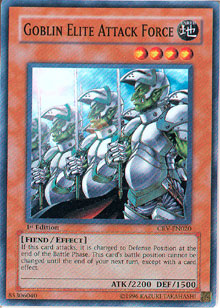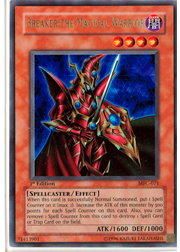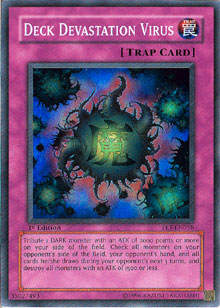Effect monsters are everywhere. If you want to find a deck at a Shonen Jump Championship that isn’t packed to the gills with them, you’ll need to take a trip to table 134 around round 5, and even then, I’m not so sure. A monster with a positive effect is invariably better than an effect-free monster with the same ATK and DEF values. Today, I’ll look at how effect monsters can be kept in check, and ways for you to beat them.
Chocolate or Vanilla?
If there’s one thing we’ve learned playing the Yu-Gi-Oh! TCG, it’s that the cookie-cutter deck usually contains the strongest combination of general spells, traps, and monsters. While these decks generally have very little in the way of theme, the goal is always the same: maintain card presence while diminishing your opponent’s options. With this theory in mind, let’s take a look at the differences between normal monsters and effect monsters.
Normal monsters offer no advantages other than their (hopefully) excellent stats. They can attack, defend, or be tributed for higher-level monsters or other card effects. Effect monsters contain everything that normal monsters do, but they add an additional effect to the game. The effects of monsters, in comparison to their ATK and DEF values, will generally follow the following guidelines:
 First, if the monster is stronger than average for its level, it will usually have a negative effect to balance out its unusually high ATK or DEF values. Berserk Gorilla, Goblin Elite Attack Force, and Zombyra the Dark are just a few of the monsters that follow this rule. The effects of such monsters will generally take away from their battle capabilities.
First, if the monster is stronger than average for its level, it will usually have a negative effect to balance out its unusually high ATK or DEF values. Berserk Gorilla, Goblin Elite Attack Force, and Zombyra the Dark are just a few of the monsters that follow this rule. The effects of such monsters will generally take away from their battle capabilities.
Second, if the monster has low ATK and DEF values, it’s often accompanied by an amazing effect. In order to offset the disadvantages of being unable to effectively destroy anything in combat, such effects will usually be very powerful (cards like Yata-Garasu and Spirit Reaper have served to define entire metagames with them). Magician of Faith and Magical Merchant are good examples of self-replacing flip effects that can provide extra advantages. For example, Magical Merchant could flip and send back Magician of Faith, Treeborn Frog, and Dark Magician of Chaos before snatching Graceful Charity from the top of your deck. Imagine if your hand contained Night Assailant, Premature Burial, and Goldd, Wu-Lord of Dark World! In this very specific case, Magical Merchant’s low stats are offset by its self-replacing effect, and it has the additional benefits of making each card in your hand much stronger.
Third, if the monster has average stats (somewhere between 1000–1800), it will usually have a decent but not overwhelming effect. Most search monsters, such as Sangan and Pyramid Turtle, fall under this category, as well as monsters with unique purposes. Such cards will often affect other parts of the duel and they may have effects than can be used both in and outside of battle (Kycoo the Ghost Destroyer, Reflect Bounder and Chiron the Mage are good examples). The effects of these monsters rarely involve attacking or defending—rather, they provide additional effects if the attack is successful, or else don’t require combat at all. Effect monsters that require battle to succeed are less useful than a monster than can do the same thing without attacking. Plus, a monster whose effect kicks in automatically will allow you to rake in the benefits, as well as allowing you to attack in the same turn.
Fourth, if the monster is a tribute, its effect tends to be very powerful. They tend to manipulate what an opponent can or cannot play and—when combined with the beefy stats that go hand-in-hand with being a tribute monster—cancel the disadvantages of having to tribute another monster to get them into play. Jinzo, Spell Canceller, Vampire Lord, and Mobius the Frost Monarch all belong to a very long list of powerful tribute monsters.
(Rule) Breaker the Magical Warrior
By expanding on our newfound knowledge, we can clearly see why certain effect monsters are extremely powerful. When the guidelines for card balance are stretched, metagame-defining monsters are born. Let’s take a look at some of the monsters that have defied the rules about balance.
Black Luster Soldier – Envoy of the Beginning has two highly advantageous effects, as well as the beefy stats expected of a two-tribute monster. However, you don’t have to tribute anything for this bad boy! That is why it had to be Forbidden. If it had no special summon requirement, it probably would have been allowed into play. Its amazing effects and stats would be consistent with a level 8 monster.
 Breaker the Magical Warrior is one of the only monsters that provides a free benefit. Its average stats allow you to gain additional benefits from the battle phase with a monster who’s already pushed tempo and card presence in your favor. It is put into check if it can be destroyed in battle, but you can turn this disadvantage around by coupling Breaker with a handful of defensive cards. That makes it more expensive to destroy the card, which can put your opponent at a disadvantage.
Breaker the Magical Warrior is one of the only monsters that provides a free benefit. Its average stats allow you to gain additional benefits from the battle phase with a monster who’s already pushed tempo and card presence in your favor. It is put into check if it can be destroyed in battle, but you can turn this disadvantage around by coupling Breaker with a handful of defensive cards. That makes it more expensive to destroy the card, which can put your opponent at a disadvantage.
Gravekeeper’s Spy is one of the few monsters with exceptional stats that also has a flip effect. Not only does it couple a decent 1200 ATK with an exceptional 2000 DEF, but it also pulls a free card from your deck to your field. What does this mean? It means that Gravekeeper’s Spy manipulates the battle phase by blocking opposing attacks at the same time that it’s generating instant card presence.
Where’s the Trump Card?
Decks in today’s metagame* depend largely on their effect monsters. Flip-Flop Control decks are the most dependent, since they maintain card presence through flip effects and defensive cards. Toolbox decks combine good effects with beefy monsters. While they aren’t as dependent on effect monsters as Flip-Flop decks, the Toolbox player won’t be able to generate quick advantages over an opponent without its effect monsters. Monarch Control decks depend on their effect monsters as well, but those monsters also double as great attackers.
 Fortunately for us, there’s something we can do to trump the power of effect monsters. We have two viable top-tier options—Skill Drain and Deck Devastation Virus—that completely hose Flip-Flop Control decks. Skill Drain also shuts down what Toolbox and Monarch Control decks want to accomplish (namely, generating advantages with effects from their monsters) and forces your opponent to play a more aggressive game, which is something that you can be ready for. The Skill Drain deck limits the opponent’s options during battle phase—if done right, he or she can do nothing but set monsters to get destroyed without any effects. Every battle phase becomes an addition to card presence for the Skill Drain player, as long as his or her monsters are big enough to take out any of the raw ATK values that a Flip-Flop or Toolbox player can dish out.
Fortunately for us, there’s something we can do to trump the power of effect monsters. We have two viable top-tier options—Skill Drain and Deck Devastation Virus—that completely hose Flip-Flop Control decks. Skill Drain also shuts down what Toolbox and Monarch Control decks want to accomplish (namely, generating advantages with effects from their monsters) and forces your opponent to play a more aggressive game, which is something that you can be ready for. The Skill Drain deck limits the opponent’s options during battle phase—if done right, he or she can do nothing but set monsters to get destroyed without any effects. Every battle phase becomes an addition to card presence for the Skill Drain player, as long as his or her monsters are big enough to take out any of the raw ATK values that a Flip-Flop or Toolbox player can dish out.
There are many ways to build a Skill Drain deck. The first involves the biggest ATK values you can find on level 4 monsters, and negating those negative effects with Skill Drain. The second involves filling the deck with high-ATK monsters that have positive effects, but aren’t heartbroken if you take them away. The third is to toss effect monsters aside and dust off those 1900 ATK vanilla beatsticks that you used to idolize. Normal monsters have a lot of decent support, and a great support card in the form of Heart of the Underdog. Each of these builds definitely has the potential to take down the metagame.
The Lesson
Now that you know why and how effect monsters work, hopefully you’ll be able to effectively counter the metagame by playing with some effect monster hate. Don’t just try Skill Drain or Deck Devastation Virus, though they’re good places to start! Consider more conventional ways of dealing with effect monsters, like Exiled Force and multiple copies of The Warrior Returning Alive, for example, and see if you can tech out your deck to prevent your opponent’s effect monsters from doing their thing.
Send all feedback, suggestions, questions and such to mpeddle80@hotmail.com. (I apologize for not putting this in my articles earlier.)
*Since we’re at the start of a new format, it’s difficult to pin down the state of the metagame at the moment. For the purposes of this article, “today’s metagame” refers to the general Toolbox, Monarch Control and Flip-Flop Control strategies.